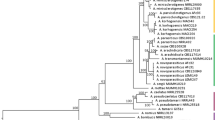Abstract
Seventeen imported raw spice samples obtained from retail outlets were examined for spoilage mould profile. A total of 665 fungal isolates, representing 14 species, were recovered and identified from dried and ground spice samples on several media using standard dilution plate method. Moisture content varied greatly among various samples and were generally high. The most heavily contaminated spice samples examined were observed in red chili and black pepper in order of magnitude of 1580 and 1120 cfu/g, respectively. The most predominant fungal genera encountered were Aspergillus, Penicillium, Rhizopus, Cladosporium and Trichoderma. Yeasts were also frequently recovered, but not identified. Relative occurrence values of taxa disclosed ranged between 36.4% for A. flavus and 0.6% for A. parasiticus and Absidia corymbifera. Samples obtained from gunny bags encounter higher colony counts and contamination frequency than other packing methods. The present magnitude of contamination and spectra of mycobiota approximate those reported for similar spice samples. Although several potentially mycotoxigenic fungi were isolated during the present study, neither the foodstuff nor the fungi were assayed for the presence of these toxins.
Similar content being viewed by others
References
W Kneifel E Berger (1994) ArticleTitleMicrobial criteria of random samples of spices and herbs retailed on the Austrian market J Food Protect 57 893–901
AK Sharma AS Ghanekar SR Podwal-Desai GP Nadkami (1984) ArticleTitleMicrobiological status and antifungal properties of irradiated spices J Agric Food Chem 32 1061–1063
NH Aziz YA Youssef MZ El-Fouly LA Moussa (1998) ArticleTitleContamination of some common medicinal plant samples and spices by fungi and their mycotoxins Bot Bull Acad Sinica 39 279–285
CM Christensen HA Fanse GH Nelson F Bates CJ Microcha (1967) ArticleTitleMicroflora of black and red pepper Appl Microbiol 15 622–628
H Hitokoto S Morozumi T Wauke S Sakai H Kurata (1980) ArticleTitleInhibitory effects of spices in growth and toxin production of toxigenic fungi Appl Environ Microbiol 39 818–822
AK Roy HK Chourasia (1990) ArticleTitleMycoflora, mycotoxin producibility and mycotoxins in traditional herbal drugs from India J Genet Appl Microbiol 36 295–302
HK Chourasia (1995) ArticleTitleMycobiota and mycotoxins in herbal drugs of Indian Pharmaceutical industries Mycol Res 99 697–703
N Misra (1981) ArticleTitleInfluence of temperature and relative humidity on fungal flora of some spices in storage Z Lebensm Unters Forsch 172 IssueID1 30–31
KB Raper DP Fennel (1977) The Genus Aspergillus Krieger Publishing Company Huntington, New York
JI Pitt (1985) A laboratory guide to common Penicillium species North Ryde Australia 184
Domsch KH, Gams W, Anderson TH. Compendium of Soil Fungi, Vol. 1. London: Academic Press, 1980, pp. 857 & II, pp. 405.
Moubasher AH. Soil fungi in Qatar and other Arab countries. University of Qatar, 1993; 566 pp.
AD King AD Hocking JI Pitt (1981) ArticleTitleThe mycoflora of some Australian food Food Technol 33 55–60
K Takatori K Watanabe S Udagawa H Kurata (1977) ArticleTitleMycoflora of imported spices and inhibitory effects of the spices on the growth of some fungi Proc Jpn Assoc Mycotoxins 9 36–38
EA Elshafie TA Al-Rashdi SN Al-Bahry CS Bakheit (2002) ArticleTitleFungi and aflatoxins associated with spices in the Sultanate of Oman Mycopathologia 155 IssueID3 155–160
S Garcia F Iracheta N Heredia (2001) ArticleTitleMicrobiological survey of retail herbs and spices from Mexican markets J Food Protect 54 99–103
JI Pitt AD Hocking (1997) Fungi and Food Spoilage Aspen Publishers Gaithersburg USA 593
CW Hesseltine RF Rogers OL Shotwell (1981) ArticleTitleAflatoxin and mold flora in North Carolina in 1977 corn crop Mycologia 73 216–228
H. Hitokoto S Morozumi T Wauke S Sakai H Kurata (1978) ArticleTitlecontamination and mycotoxin detection of powdered herbal drugs Appl Environ Microbiol 36 252–256
AAK Abou-Arab MS Kawther ME El Tantawy RI Badeaa N Khayria (1999) ArticleTitleQuantity estimation of some contaminants in commonly used medicinal plants in the Egyptian market Food Chem 67 357–363
G Lwellyn C Mooney RL Cheatle B Flanningan (1990) ArticleTitleMycotoxin contamination of spices – an update Int Biodeteriorat Biodegrad 29 111–121
Author information
Authors and Affiliations
Corresponding author
Rights and permissions
About this article
Cite this article
Mandeel, Q.A. Fungal contamination of some imported spices. Mycopathologia 159, 291–298 (2005). https://doi.org/10.1007/s11046-004-5496-z
Received:
Accepted:
Issue Date:
DOI: https://doi.org/10.1007/s11046-004-5496-z



